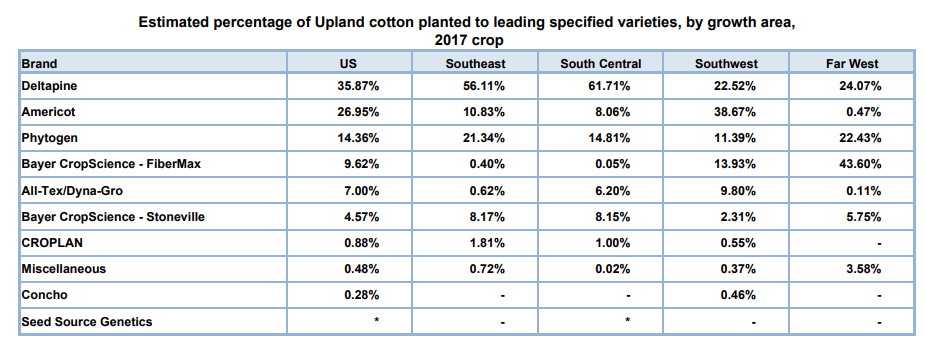The Deltapine brand of Upland cottonseed was the most popular planted in the United States for the 2017-2018 season, according to the USDA, Agricultural Marketing Service’s Cotton and Tobacco Program. The Americot brand was the second most popular followed by Phytogen, Bayer CropScience FiberMax, All-Tex/Dyna-Gro and Bayer CropScience Stoneville.
Deltapine brand varieties were the most popular planted in 2017, accounting for 35.9 percent of the United States acreage. This brand accounted for 56.1 percent of the acreage planted in the southeastern states (Alabama, Florida, Georgia, North Carolina, South Carolina, and Virginia). It accounted for about 61.7 percent in the south central states (Arkansas, Louisiana, Mississippi, Missouri, and Tennessee), 22.5 percent in the southwestern states (Texas, Oklahoma, and Kansas), and 24.1 percent in the western states (Arizona, California, and New Mexico). Deltapine’s most popular varieties were DP 1646 B2XF, DP 1518 B2XF, DP 1522 B2XF, and DP 1538 B2XF, accounting respectively for 14.8, 4.7, 4.4, and 1.8 percent of the U.S. Upland cotton acreage.
Americot brand varieties were the second most popular planted in 2017, accounting for 27.0 percent of the United States acreage. These varieties accounted for 10.8 percent of the acreage planted in the southeastern states, 8.1 percent in the south central states, 38.7 percent in the southwestern states, and 0.5 percent in the western states. The most popular Americot varieties were NG 3406 B2XF, NG 4545 B2XF, NG 3500 XF, and NG 3517 B2XF, accounting respectively for 10.9, 4.3, 4.3, and 2.4 percent of the United States acreage planted to Upland cotton.
Phytogen brand varieties were the third most popular planted in 2017. These varieties accounted for 14.4 percent of the acreage planted. They accounted for 21.3 percent of the acreage planted in the southeastern states, 14.8 percent of the acreage in the south central states, 11.4 percent in the southwestern states and 22.4 percent in the western states. The most popular Phytogen varieties were PHY 444 WRF, PHY 333 WRF, and PHY 490 W3FE
accounting respectively for 3.9, 3.4, and 2.1 percent of the United States acreage planted to Upland cotton.
Bayer CropScience FiberMax brand varieties were the fourth most popular planted in 2017, accounting for 9.6 percent of the United States acreage. They accounted for 0.4 percent of the acreage planted in the southeastern states, 0.1 percent of the acreage in the south central states, 13.9 percent in the southwestern states and 43.6 percent in the western states. The most popular Bayer CropScience FiberMax brand varieties were FM 1830GLT, FM 2011GT, and FM 2334GLT, accounting respectively for 2.8, 1.2, and 1.2 percent of the United States acreage planted to Upland cotton.
All-Tex/Dyna-Gro brand varieties were the fifth most popular and accounted for about 7.0 percent of the U.S. acreage planted in 2017. Bayer CropScience Stoneville varieties were the sixth most popular and accounted for about 4.6 percent of the 2017 cotton acreage.
Phytogen was the most popular brand of American Pima varieties planted in 2017. Phytogen variety PHY 881 RF accounted for 42.6 percent of the United States Pima acreage. Phytogen’s PHY 841 RF was the second most planted American Pima variety and accounted for 17.4 percent of the U.S. crop. Phytogen’s PHY 888 RF was the next most popular variety and accounted for 10.2 percent of the U.S. Pima acreage.
Estimates of the percentage of the various varieties of cotton planted in the United States for 2017 were based on informal surveys made by the Cotton and Tobacco Program Classing Offices. Those surveyed included ginners, seed dealers, extension agents, and other knowledgeable sources.
Πηγή: USDA


